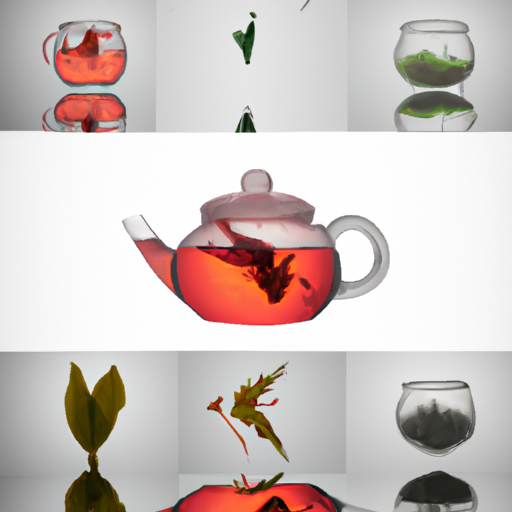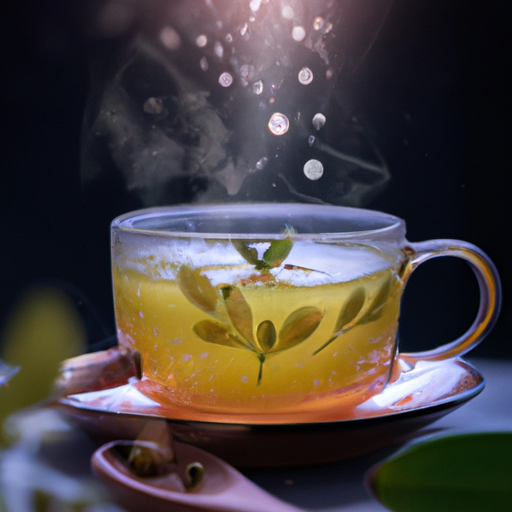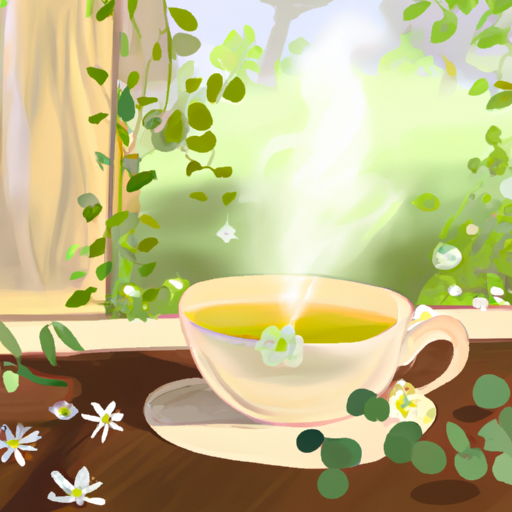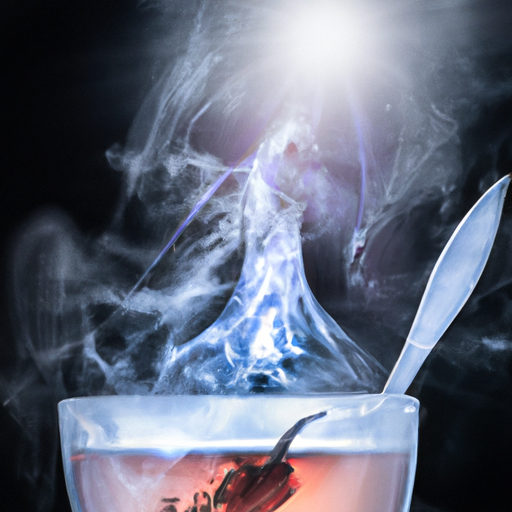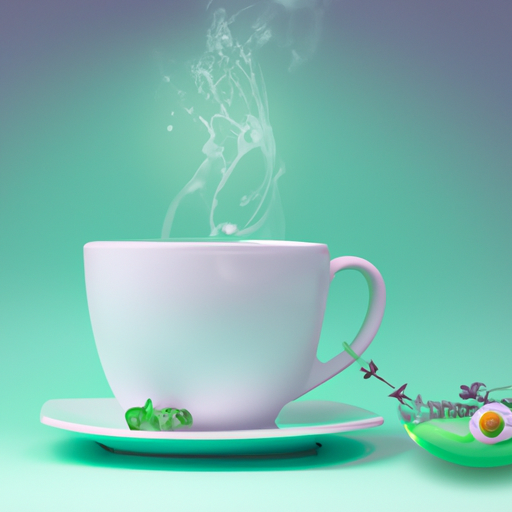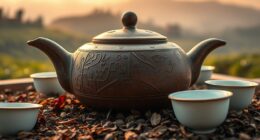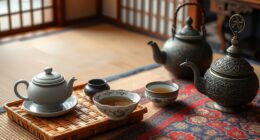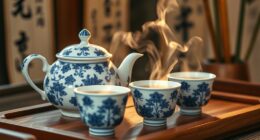Did you know that herbal tea can be steeped multiple times? In fact, on average, herbal tea can be steeped up to three times, extracting different flavors and aromas with each steep.
Understanding the steeping process is key to maximizing the potential of your herbal tea. Factors such as water temperature, steeping time, and the quality of the tea leaves all play a role in determining how many times you can steep your tea.
In the first steep, you can enjoy the full flavor of the tea, while the second steep extracts the remaining flavors. However, beyond the third steep, the brew becomes weaker and less flavorful.
But don’t throw away those spent tea leaves just yet! There are creative ways to repurpose them. In this article, I will delve into the details of the steeping process, discuss the factors that affect herbal tea steeping, and provide tips for maximizing the steeping potential of your herbal tea.
So grab your favorite herbal tea and let’s dive in!
Key Takeaways
- Herbal tea can be steeped multiple times, up to three times on average.
- Factors like water temperature, steeping time, and tea leaf quality determine the number of times herbal tea can be steeped.
- The first steep extracts the full flavor, while the second steep extracts remaining flavors.
- After the third steep, the brew becomes weaker and less flavorful.
Understanding the Steeping Process
You might be surprised at just how many times you can steep herbal tea, allowing its flavors to unfold and deepen with each infusion. Maximizing flavor is all about experimenting with steeping techniques to find the perfect balance.
When it comes to herbal tea, there are no hard and fast rules. It’s all about personal preference and taste. Some people prefer a stronger brew and will steep their herbal tea for longer periods of time, while others prefer a lighter flavor and will opt for shorter steeping times.
One way to maximize the flavor of your herbal tea is to use the right amount of tea leaves. The general rule of thumb is to use one teaspoon of tea leaves for every eight ounces of water. However, you can adjust this ratio to suit your taste. If you prefer a stronger flavor, you can add more tea leaves. If you prefer a milder flavor, you can use less.
Another factor to consider is the water temperature. Different herbal teas require different water temperatures for optimal flavor extraction. For example, delicate herbal teas like chamomile and mint are best steeped in water that’s around 200°F, while bolder herbal teas like rooibos and hibiscus can be steeped in boiling water.
Incorporating these techniques and experimenting with steeping times and temperatures will help you find the perfect cup of herbal tea that suits your taste. Understanding the factors that affect herbal tea steeping is essential for achieving the desired flavor profile.
Factors That Affect Herbal Tea Steeping
When it comes to steeping herbal tea, there are several factors that can significantly impact the taste and quality of the brew. The type and quality of the tea leaves play a crucial role, as different herbs and blends have varying steeping requirements.
Additionally, the water temperature and steeping time are also important considerations, as they can affect the release of flavors and beneficial compounds from the tea leaves.
By paying attention to these factors, you can ensure a perfect cup of herbal tea every time.
Type and Quality of the Tea Leaves
To get the most flavor out of your herbal tea, let the high-quality tea leaves steep multiple times. This is because the type and quality of the tea leaves play a crucial role in determining how many times you can steep your herbal tea. Here are four factors to consider:
-
Freshness: Fresh tea leaves will release more flavor and aroma, allowing for multiple steeps.
-
Leaf size: Smaller leaves tend to release their flavor more quickly, resulting in shorter steeping times and the potential for more steeping sessions.
-
Processing method: Different processing methods can affect the flavor extraction rate, impacting the number of times you can steep the tea leaves.
-
Blend or single origin: Blended herbal teas may offer more complexity and depth, allowing for multiple steepings.
Considering these factors will help you maximize the flavor and benefits of your herbal tea. Moving forward, let’s explore the impact of water temperature and steeping time on the brewing process.
Water Temperature and Steeping Time
Get ready for a wild ride as we dive into the fascinating world of water temperature and steeping time!
When it comes to brewing herbal tea, the optimal water temperature plays a crucial role in extracting the flavors and health benefits from the tea leaves. Different types of herbal teas require specific water temperatures to achieve the best results.
For delicate herbal teas like chamomile or lavender, a lower temperature of around 175°F is recommended to prevent bitterness and preserve the delicate floral notes. Stronger herbal teas like peppermint or ginger can be brewed at a higher temperature of around 200°F to extract the robust flavors.
Additionally, steeping time is equally important in achieving the perfect cup. Generally, herbal teas are steeped for 5-7 minutes, but it’s essential to follow the instructions provided by the tea manufacturer to ensure optimal flavor extraction.
Now, let’s move on to the next section where we explore the first steep: enjoying the full flavor.
First Steep: Enjoying the Full Flavor
Steeping herbal tea brings out its full flavor and can be done multiple times. When exploring different tea varieties, it’s important to consider the water quality as it greatly impacts the taste and overall experience. Here are three factors to keep in mind when enjoying the first steep of herbal tea:
-
Tea Varieties: There’s a wide range of herbal teas available, each with its unique flavor profile. From soothing chamomile to refreshing peppermint, each variety requires a specific steeping time and water temperature to bring out its best flavors. Experimenting with different herbal teas allows you to discover your personal favorites and enjoy a diverse tea-drinking experience.
-
Water Quality: The quality of water used for steeping is crucial. Using filtered or spring water ensures that impurities and chlorine won’t interfere with the delicate flavors of herbal tea. Additionally, water temperature plays a vital role in extracting the full potential of the tea leaves. Generally, herbal teas require boiling water around 205°F (96°C) to enhance their taste.
-
Steeping Time: Herbal tea requires a longer steeping time compared to other types of tea. To fully extract the flavors, steeping for 5-7 minutes is recommended. However, it’s essential to follow the instructions specific to the tea variety you’re brewing, as steeping times may vary.
As you enjoy the first steep and savor the rich flavors of herbal tea, the subsequent section will delve into the second steep, where the remaining flavors are expertly extracted.
Second Steep: Extracting Remaining Flavors
Delve into the realm of extracting the remaining flavors by expertly preparing a second steep of your beloved herbal infusion. After savoring the initial brew, there’s no need to discard those precious leaves just yet. In fact, the second steep offers a unique opportunity to unlock even more of the tea’s hidden gems.
The process of a second steep involves allowing the leaves to release their remaining benefits and flavor variations. As you pour hot water over the leaves, their essence unfurls once again, revealing a slightly different taste profile. This second extraction often brings out subtler notes that may have been overshadowed in the first steep, allowing you to appreciate a whole new dimension of the tea.
To ensure a successful second steep, it’s important to adjust the brewing time and water temperature. Generally, a slightly longer steeping time is needed to extract the remaining flavors fully. Experimenting with different steeping durations can help you find the perfect balance between strength and taste.
As you embark on the journey of the second steep, you’ll be rewarded with a brew that still holds the essence of the initial infusion, yet offers its own unique character. So, prepare yourself for a delightful exploration of flavors as we now transition to the subsequent section about the ‘third steep and beyond: a weaker brew’.
Third Steep and Beyond: A Weaker Brew
Prepare yourself for a delightful exploration of flavors as we’re now moving on to the third steep and beyond, where you’ll experience a brew with a milder taste.
When steeping herbal tea for the third time and beyond, it’s important to note that the resulting brew will be weaker compared to the initial steep. This is because most of the flavors and nutrients have already been extracted in the previous infusions. However, don’t let this discourage you! There’s still plenty of enjoyment to be found in these subsequent steeps.
To get the most out of your weaker brew, you can adjust the steeping time to ensure a balance between flavor and strength. Experimentation’s key here, as you may find that steeping for a shorter or longer period of time produces the desired taste for you. It’s also worth noting that some herbal teas, such as chamomile or mint, tend to hold up better to multiple infusions compared to others.
As we move into the subsequent section about creative ways to use spent tea leaves, it’s important to remember that the journey doesn’t end with the third steep. There are still possibilities to explore and flavors to uncover. So, let’s dive into the exciting world of repurposing spent tea leaves and discover the many ways they can be used beyond steeping.
Creative Ways to Use Spent Tea Leaves
Once you’ve reached the third steep and beyond, get ready to explore the creative world of repurposing spent tea leaves and uncover the surprising ways they can be used. Don’t throw those tea leaves away just yet! There are numerous ways to use leftover tea leaves that can benefit both your body and your home. Let’s dive into some DIY beauty treatments with tea leaves that will leave you feeling refreshed and rejuvenated.
| Uses for Leftover Tea Leaves | Benefits |
|---|---|
| Facial Toner | The antioxidants in tea leaves can help tighten and refresh your skin, leaving it glowing and radiant. Simply steep the leaves in hot water, let it cool, and apply to your face with a cotton pad. |
| Hair Rinse | Tea leaves can add shine and softness to your hair. Brew a strong cup of tea, let it cool, and use it as a final rinse after shampooing. |
| Eye Compress | Place cooled tea bags on your eyes to reduce puffiness and soothe tired eyes. The caffeine in the tea helps constrict blood vessels, minimizing under-eye bags. |
| Foot Soak | Create a relaxing foot soak by steeping the tea leaves in warm water. The tannins in the tea can help soothe tired feet and eliminate odors. |
| Air Freshener | Dry out the used tea leaves and place them in a sachet or bowl to naturally freshen the air in your home. |
These are just a few examples of the creative ways you can use spent tea leaves. So, before you toss them out, consider giving them a second life in your beauty routine or around the house. Now, let’s move on to some tips for maximizing steeping potential without compromising flavor.
Tips for Maximizing Steeping Potential
Explore these helpful tips to make the most of your tea steeping experience and unlock the full potential of your favorite brews, leaving you feeling satisfied and delighted. Maximizing flavor and experimenting with steeping can truly enhance your herbal tea experience. Here are five expert tips to help you get the most out of each steep:
-
Water temperature: Different herbal teas require different water temperatures for optimal flavor extraction. Experiment with varying temperatures to find the sweet spot for each type of tea.
-
Steeping time: Adjusting the steeping time can greatly affect the flavor profile of your herbal tea. Start with the recommended time and gradually increase or decrease it to discover your preferred taste.
-
Multiple infusions: Some herbal teas can be steeped multiple times, releasing different flavors with each infusion. Don’t be afraid to experiment with additional steepings to fully explore the tea’s complexity.
-
Tea-to-water ratio: Finding the right ratio of tea leaves to water is crucial for maximizing flavor. Adjusting the amount of tea you use can significantly impact the taste and strength of your brew.
-
Pre-warming your teapot: By pre-warming your teapot with hot water, you ensure that the temperature remains consistent throughout the steeping process, allowing the flavors to fully develop.
By following these tips and experimenting with different steeping techniques, you can unlock the full potential of your herbal tea and enjoy a rich and flavorful cup every time. Happy steeping!
Frequently Asked Questions
Can I steep herbal tea more than three times?
Herbal tea can be steeped multiple times, but each subsequent steeping will affect the flavor. The first steeping usually produces the strongest flavor, while subsequent steepings may become weaker.
What happens if I steep herbal tea for too long?
Steeping herbal tea for too long can lead to a stronger, bitter taste and a loss of delicate flavors. It may also result in a higher concentration of certain phytochemicals, which can have potential health benefits. Some of the best herbal teas for relaxation include chamomile, lavender, and peppermint.
Are there any herbal teas that can only be steeped once?
Yes, some herbal teas, like chamomile or lavender, are meant to be steeped only once for optimal flavor. To properly store herbal tea, keep it in an airtight container away from light and moisture. Herbal tea offers various health benefits, such as promoting relaxation and aiding digestion.
How long should I wait in between each steeping?
You should wait approximately 5 minutes in between each steeping to allow the flavors to fully develop. Herbal teas can be steeped multiple times, which means you can enjoy their delicious taste again and again.
Can I mix different types of herbal tea leaves together for steeping?
Yes, you can mix different types of herbal tea leaves together for steeping. Combining flavors creates unique blends and enhances the health benefits. Experimenting with various combinations allows you to customize your tea experience.
Conclusion
After delving into the art of steeping herbal tea, I’m reminded of the delicate dance of flavors that unfolds with each infusion.
Just like a skilled conductor leading an orchestra, the first steep offers a symphony of robust notes. The second steep, a subtle encore, extracts the remaining melodies. However, as we delve into the third and beyond, the brew becomes a faint whisper of its former self.
Yet, fear not, for even in its weakened state, spent tea leaves can still find purpose in other culinary endeavors. With these tips in mind, you’re now equipped to maximize the potential of your herbal tea steeping journey.

